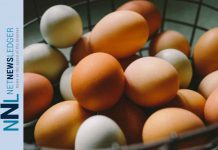
Research suggests that the alternative hen housing will push up egg prices
GUELPH, Ont.- LIVING – Today’s food consumers increasingly challenge firms and farmers to change their production practices, but the evolution carries costs.
One of the first challenges to 21st century agriculture was how to define and label organic food. According to a report by Statistics Canada, in 2011 less than two per cent of Ontario farms are organic, but organic farming still receives a great deal of attention.
Fast-food firms – McDonald’s, Burger King, Tim Hortons and others – recently announced plans to use only eggs from cage-free hen housing systems. The Egg Farmers of Canada followed with its own announcement that the use of conventional cages – often referred to as battery cages – will end by 2036.
Presumably fast-food firms have assessed the situation and decided any loss of business due to increased egg prices will be offset by the competitive advantages of marketing their eggs as cage-free. Or perhaps they are willing to absorb any increase in the cost of purchasing cage-free eggs in order to maintain their customer base. We also assume that the Egg Farmers of Canada disallowed future use of conventional cages because they believe that is consistent with good farm practices and their long-term marketing strategy.
But there is no free lunch. Research suggests that the alternative hen housing will push up egg prices, although this may be a small price to pay for production practices that enable hens to pursue natural tendencies like perching, nesting, spreading their wings, etc.
So the new standards governing production practices could enhance the well-being of some consumers and improve animal welfare for hens.
However, we must recognize that the gains and losses associated with these changes will not be uniform.
Some consumers – especially those with strong concerns about animal welfare – may benefit greatly. Others, less concerned about animal welfare, may still find themselves paying slightly higher prices.
Some egg farmers may make timely and profitable adjustments to their production practices. Others may not be so fortunate.
Even the hens’ welfare will vary. Some hens will enjoy the new freedom to roam but others may fall victim to attacks from other hens that would have otherwise been caged.
We all have a stake in the outcome of the emerging discussions around animal welfare and agricultural production. As these issues are resolved, some members of society have more information and focused interests than others. The challenge is to ensure that those who are affected have high-quality information about the tradeoffs they face when confronted with conventionally produced eggs and eggs from alternative housing systems. Quality information is needed all along the supply chain, from the farmer to the end consumer.
Recent research conducted by Professor John Cranfield demonstrates the importance of information on the kind of tradeoffs consumers face each day at the grocery store.
In his research, one set of consumers received scientifically validated information about the positive and negative consequences of alternative hen housing systems. The other set of consumers did not have this information — they only received a description of the different hen housing systems. The preliminary findings suggest that there is a premium for cage-free eggs in both cases. Interestingly, however, when consumers had information on the positive and negative consequences of alternative hen housing they were willing to pay relatively less for cage-free eggs than consumers who did not have this information.
Twenty-first century agriculture is evolving and animal welfare will likely remain an issue. The system that emerges will be at its best if the evolving preferences, standards and rules are accompanied by increasing efforts to provide an informed understanding of the tradeoffs involved.
This effort is a priority for academics and relies, in part, on our ability to communicate effectively on the issues. Stay tuned as the industry continues to evolve.
By Brady Deaton, Jr. (@BradyDeatonJr) and John Cranfield (@agecprof) are professors in the Department of Food, Agricultural and Resource Economics (FARE) at the University of Guelph.
© 2016 Distributed by Troy Media
The views, opinions and positions expressed by all Troy Media columnists and contributors are the author’s alone.

